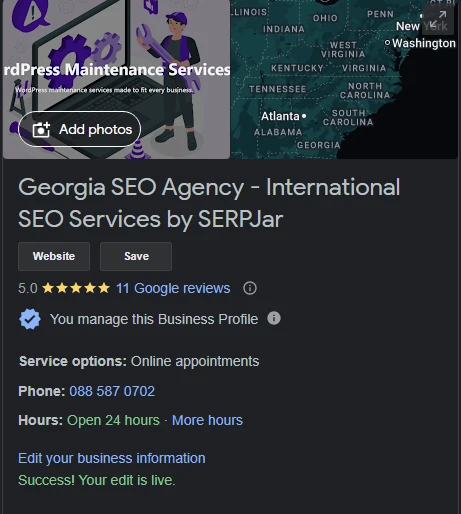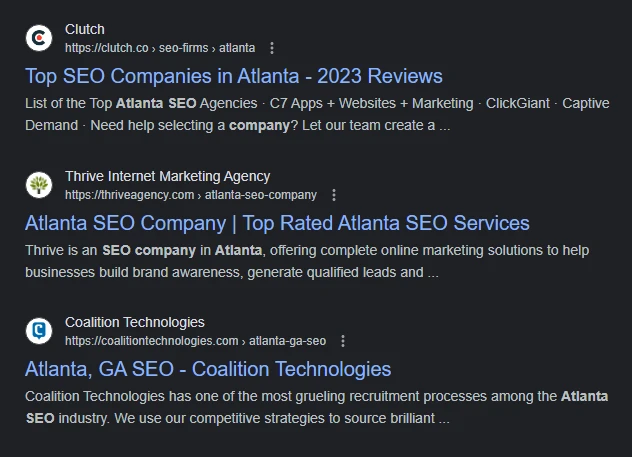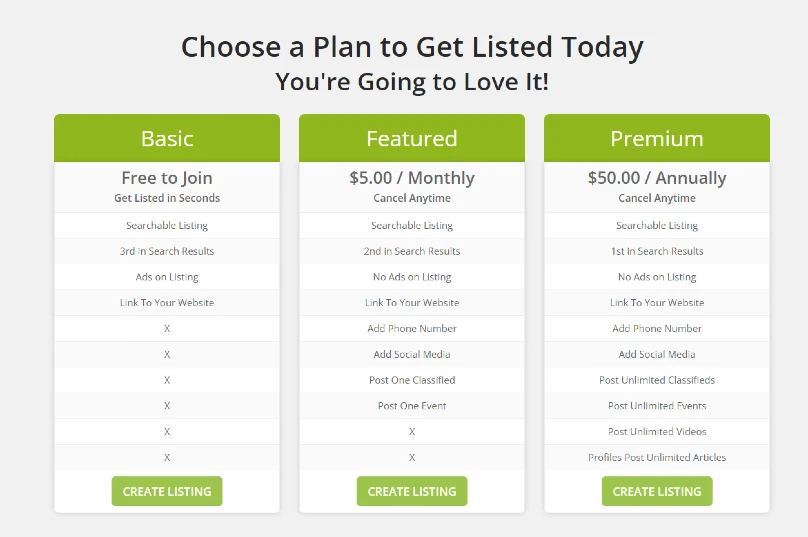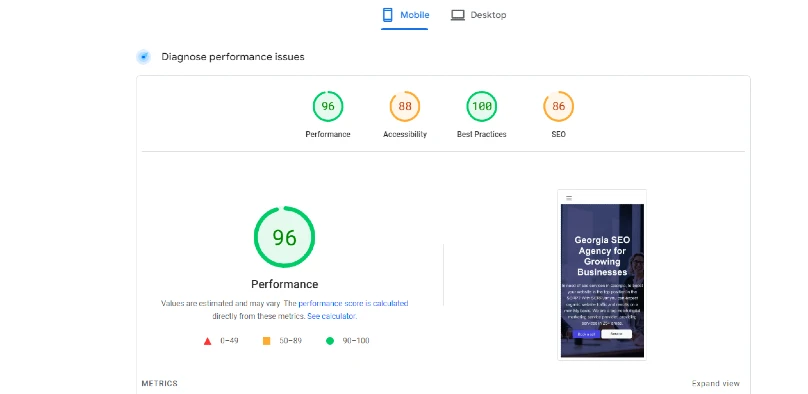Optimizing your business for local search queries is a great way to receive more customers.
And while there are hundreds of ways to do that, we are going to outline the 12 most important local SEO tips to optimize your business.
On average 40% of global searches are done locally, meaning it’s crucial to optimize your business for more local search terms.
After all, local search is how customers find and interact with your business. However, if you are not in the top 3 spots of Google, your chances of getting clients are near zero.
That’s why we created a list with powerful local tips, which will help you optimize your website for better rankings.
Local SEO Tips for Optimizing Local Businesses
Optimize Your Google Business Profile
When optimizing for local search, it is crucial to work on your Google Business Profile first. It’s one of the top tools, which helps you rank in the Google local SERP.
Nonetheless, it is also a part of the local pack, which contains a map, local listings, and organic search results.

Optimizing your Google Business Profile requires filling out the important business information. Such information includes business hours, locations supported, and images relevant to your business.
Along with that, Google Business Profiles can be linked with social media accounts, and outline what payment methods they work with. It’s very helpful for residential service providers and contractors, making GBP an easier place to find services.
If you want to find more information, you can review the Google FAQs page, regarding business profiles and listings.
Find Local Keywords With Buyer Intent
By utilizing keyword research, you are deemed to receive more organic traffic, but that is not quite right. Along with local keywords, you will also need to understand the intent of each keyword.
Currently, there are 3 different keyword intents – navigational, information, and transactional.
From these intents, transaction is at the bottom of the funnel, and consists of keywords, which are associated with purchases of products, services, and other goods.
Many local business owners grasp the opportunity to fill their pages with informational keywords and leave the transactional ones behind.
However, the local transactional queries are the ones bringing revenue along with traffic.
To find good local keywords with transactional intent, you can use a keyword tool like Semrush, Ahrefs, or by using Google.

All you need to do is type a query you may think is associated with purchases and review Google. If the first results show purchasable products, then you found a transactional query.
You can check its traffic from the Google Keyword Planner, which will give you how many people search for the keyword in your target area.
Create Review Pages for Trust
Review pages are one of the most important factors for local businesses and strengthening the trust in your brand. It’s also a direct ranking signal from the Google EEAT algorithm update.
Not only your website seem more trustworthy in search engines’ eyes, but you will also boost your conversion rate.
Websites like Yelp, and Clutch.co, Trustpilot, and Angie’s List have been deemed as highly authoritative pages.

Listing yourself in any of them can help establish trust between you and your customers and:
- Grab reviews from your customers
- Respond to questions and help clients purchase your products
- Boost your brand visibility, making your business a magnet for new local customers
- Showcase reviews on your website
- Win awards from websites like Clutch for services, support, and many others
Create Citations Around Your Business
For local businesses, NAP is the most critical ranking factor that determines rankings in the local SERP. As NAP stands for Name, Address, and phone number, these are the 3 top things, that your customers may be searching for, when reviewing your business.
Adding the NAP of your business on every social media page, local business directory, and other listings, sends positive signals back to your business.
For example, local business directories are a powerful way to boost your presence but need to include the correct information.

A good tip for using your phone number could be adding a DNI (Dynamic Number Insertion). It’s a powerful way to track the calls and distinguish quality from quantity when speaking with customers.
It’s also a popular way to track how many people are calling from specific pages and optimize accordingly.
As for the address, you will need to be using a legitimate physical address, otherwise, citations may not be the perfect solution for you. Adding fake address information or PO boxes will not penalize your business, but bring bad user signals and reviews.
Create Location Specific Pages
If you are a business owner operating in multiple locations, creating a page for each town, country, or region you are serving is a good practice.
For example, if you operate your business in Georgia, listing all towns inside the state can help you appear for multiple local searches.

A key to creating a successful multiple-location SEO strategy is including your target location inside:
- The title of your page
- In the URL of your page
- In the H1 with a similar/exact text to the title
- In a single or multiple H2 tags
- Inside the body text of your page
- Image alt tags
Nonetheless, you will also need to add one extra layer. If you have a set of multiple services, you can target the state of Georgia with all the services, and add locations supported.
This way you will have a unique silo structure including all services and location pages.
Install Heatmaps on Your Website
Heatmaps are another great way to boost your local SEO strategy by tracking which sections of your pages are getting the most traction.
A heatmap can help you understand the best where your users scroll to view content most. The results are given in a graphical representation, where user behavior is tracked.
They are the perfect solution for optimizing on-page local SEO, by shifting important content or repurposing pages to increase user retention.
There are 3 types of heatmaps, which you can implement on your website for more results:
- Scroll Maps: Represents how far users scroll down on any of your pages, helping you to analyze how far users need to scroll before to understand your content.
- Click Maps: Represents where users click on any given page, which is crucial to CTR.
- Hover Maps: Represents when users hover with their maps on different sections of your pages.
Start Local Link Building
Local link building is one of the most effective strategies for off-page local SEO. It helps you to compile effective strategies for gathering local links, which can improve your rankings.
By receiving more external links to your website, you are also bound to increase the DA (Domain Authority) or DR (Domain Rating) scores of your website.
However, not every link is perfect or suitable for your business. It is best to search for backlinks near your niche or speak about it.
A great way to start with your local link building would be through building local citations. You can also review our list of local citation websites, compiled for every business.
Improve Website Loading Speed
Website loading speed is yet another important factor in the Google EEAT algorithm. It plays an important part for the local SERP, as local searchers prefer to have fast-loading sites to make a purchase.
At least 88% of the local businesses get calls or receive customers within 24 hours. Yet, more than 34% of these people will leave the website if it loads for more than 3 seconds. For each second 11% of converting customers leave, giving Google a bad signal, which could result in keyword fluctuation.

To optimize your website for speed you can implement a few tips such as:
- Resize the images on your website
- Change your image formats to WebP for accelerated loading
- Decrease the plugins or scripts used
- Add caching to avoid repeated downloads
- Use asynchronous loading for CSS and JS files
- Eliminate 404 errors and bad requests
- Reduce the number of redirects on your website
Implement Local Schema on Your Website
Schema Markup is an indirect, but very popular way to strengthen your website’s authority. There are more than a hundred different schemas in existence, but only a few may apply to your local business.
For example, local schema and reviews schema are the most popular solutions, and crucial to executing local SEO strategies.

If you are not sure if you should add schema, here are a few reasons why you should include it:
- Provides rich snippets in the SERP
- Helps search engines better understand your content
- Can display products, ratings, prices, and others
- This can be shown in the Google Products tab
For example, implementing local schema on your homepage can provide the search bots with valuable information, such as:
- The name of your business
- Price ranges
- Areas served and more
And if your website starts appearing for snippets local searchers will be more interested in visiting you amongst others in the local SERP.
Improve Pages with Google Search Console Reports
The last, but most important tip for improving your website’s local SEO results is by tracking the keyword positions in Google Search Console.
All you need is to check the data from the last 28 days and check all keywords between positions 5 and 20.
Reveal the pages that rank for these keywords and save them in a spreadsheet. After that, check if these keywords are mentioned anywhere in the body of your website.
If the keywords were not included in the body of your page, make sure to add them. Once added, submit the pages for indexing and review the keyword changes over time.
